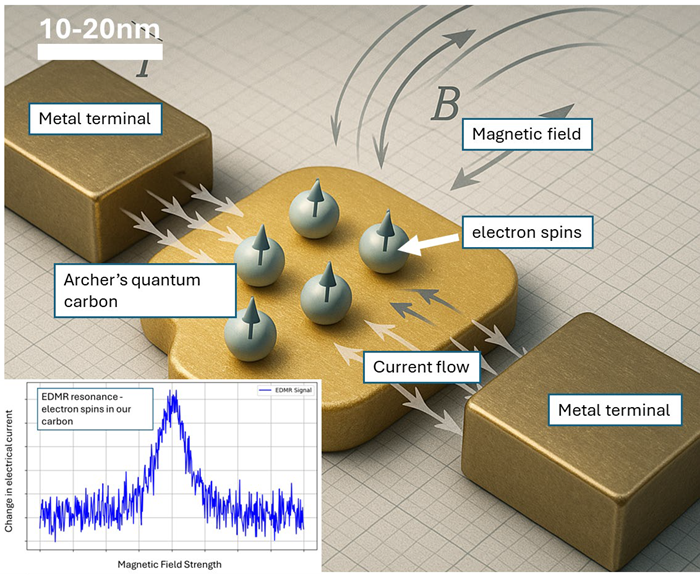Archer Materials Limited (“Archer”), a semiconductor company advancing quantum technology and medical diagnostics industries, has achieved a significant milestone in its quantum technology development by demonstrating electrical detection of electron spin resonance (EDMR) on its carbon qubit film material.
 Schematic illustration of what an on-chip device using EDMR for qubit readout or magnetic sensing would look like. The device would be nanoscale, straightforward to fabricate, and would be integrated with Archer’s microwave resonators. Example measurement shown - the magnetic field (electron spins) are sensed by a change in current through the device. Image Credit: Archer Materials Limited
Schematic illustration of what an on-chip device using EDMR for qubit readout or magnetic sensing would look like. The device would be nanoscale, straightforward to fabricate, and would be integrated with Archer’s microwave resonators. Example measurement shown - the magnetic field (electron spins) are sensed by a change in current through the device. Image Credit: Archer Materials Limited
In collaboration with École Polytechnique Fédérale de Lausanne (EPFL), Archer has successfully demonstrated on-chip detection of electron magnetic resonance (EDMR) in its advanced carbon spin qubit materials.
Early measurements at temperatures between 17 K and 25 K have successfully captured resonance signatures through changes in device current, validating the on‑chip electrical readout approach. These findings lay the groundwork for developing high-sensitivity quantum magnetic sensors and advancing toward practical quantum computing applications.
Traditional qubit and sensing readout methods for diamond-based systems rely on optical techniques, which are bulky, expensive, and hard to scale. By contrast, electrical spin detection using EDMR simplifies hardware, enables smaller, integrated devices and is compatible with conventional semiconductor electronics.
The team is now focused on integrating EDMR capabilities directly onto microfabricated test devices built around Archer’s carbon qubit materials. The demonstration of EDMR opens up another parallel path to qubit readout.
EDMR isn’t just for quantum computing—it can be used to develop highly sensitive magnetic field sensors which can be applied in biomedical devices, materials science, navigation and Defence.
The “on-chip” EDMR means that the EDMR detection circuit is integrated onto a semiconductor chip—a huge step for reducing system complexity and aligning with established chip fabrication techniques. This is essential for real-world, commercial quantum devices.
This work leverages Archer’s core strengths in carbon qubit materials synthesis and device engineering and is supported by EPFL’s expertise in spin resonance techniques. Successful development of a purely electrical readout path will reduce system complexity, lower cost and enable integration with standard semiconductor fabrication processes.
Looking ahead, Archer and EPFL will focus on enhancing device performance, aiming to achieve robust signal-to-noise ratios at higher operational temperatures. The ongoing research will also explore the integration of this technology into practical quantum computing and magnetic sensing applications.
Commenting on the carbon film development, Dr. Simon Ruffell, CEO of Archer, said,
“Electrical detection of spin resonance in carbon films is a critical milestone for Archer. By moving beyond optical readout methods used in diamond‑based systems, our technology promises simpler, more scalable quantum sensors as well as being another enabler for qubit readout.
This work has provided the team with another technical building block to contribute to qubit demonstration next year.”